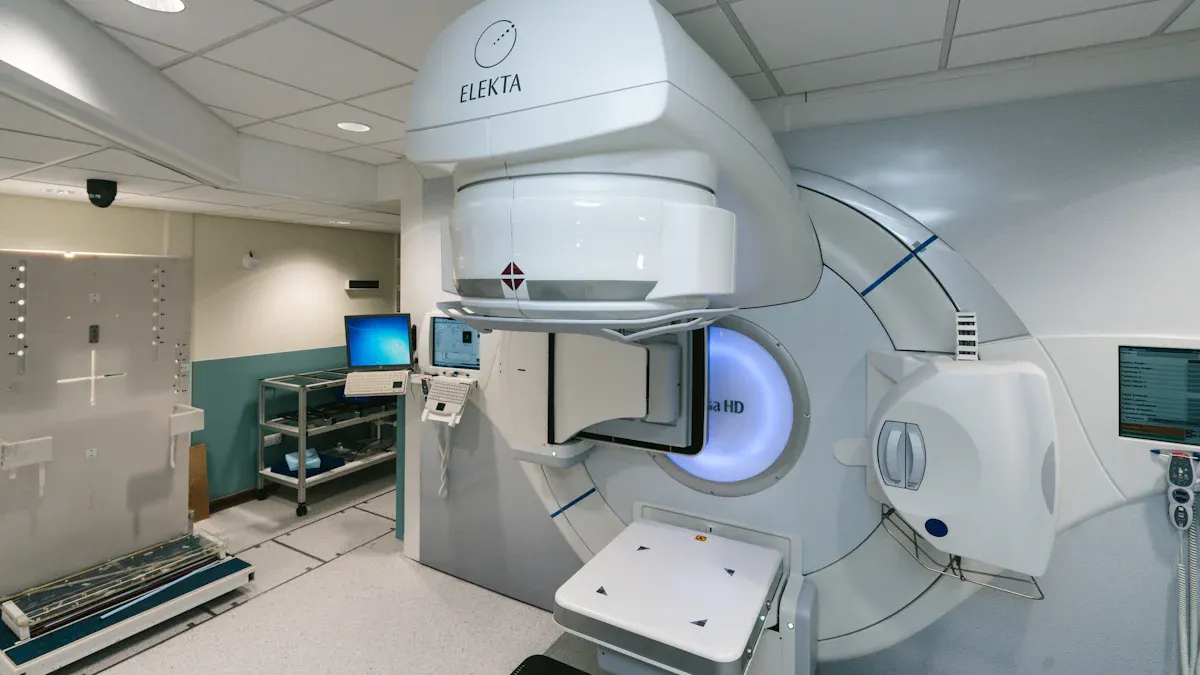Is Cancer Treatment Always Invasive? Learn Modern Options

You might wonder, "Is cancer treatment always invasive? Exploring modern options reveals that it doesn’t have to be." Advances in medicine now offer less invasive treatments like molecularly targeted therapy and immunotherapy. These methods focus on specific molecules involved in cancer growth, making them precise and less toxic than traditional approaches. By reducing physical strain, these treatments aim to improve your experience while maintaining effectiveness.
Key Takeaways
New cancer treatments are less invasive and focus on comfort.
Targeted therapy and immunotherapy attack cancer cells directly.
These methods cause fewer side effects and work better.
Small surgeries heal faster and have fewer problems than old ways.
Special radiation, like proton therapy, protects healthy body parts.
Talking to your doctor helps you choose the right treatment.
Is Cancer Treatment Always Invasive? Exploring Modern Options
What Are Less Invasive Treatments
Modern cancer treatments have evolved to offer less invasive options that prioritize your comfort and recovery. These methods aim to treat cancer effectively while minimizing the physical and emotional toll on your body. Unlike traditional approaches, which often involve extensive surgeries or aggressive therapies, less invasive treatments focus on precision and targeted action.
Some examples include:
Targeted therapy, which blocks the growth of cancer cells without harming healthy tissues.
Immunotherapy, a method that strengthens your immune system to fight cancer naturally.
Ablation therapy, which destroys tumors by freezing or burning them, eliminating the need for open surgery.
These advancements demonstrate how modern medicine continues to refine cancer care, offering you effective alternatives to invasive procedures.
Benefits of Less Invasive Methods
Reduced Recovery Time
Less invasive treatments often mean shorter recovery periods. For instance, minimally invasive surgeries, such as robotic procedures, involve smaller incisions. This reduces healing time, allowing you to return to your daily life faster. Neoadjuvant therapy, which shrinks tumors before surgery, can also make procedures less complex and recovery more manageable.
Lower Risk of Complications
Minimally invasive methods reduce the likelihood of complications. Techniques like advanced radiotherapy target tumors with precision, sparing healthy tissues from unnecessary damage. This approach lowers the risk of side effects, ensuring a safer treatment experience for you.
Improved Quality of Life During Treatment
These treatments aim to maintain your quality of life. For example, robotic surgeries and targeted therapies minimize physical strain, enabling you to stay active and engaged. Studies show that patients undergoing less invasive methods report better overall well-being compared to those receiving traditional treatments.
Did you know? Minimally invasive surgeries not only improve recovery but also reduce complications, especially for patients with limited access to specialized care.
Modern Less Invasive Cancer Treatment Options

Targeted Therapy
How it works
Targeted therapy focuses on specific molecules that drive cancer growth. Unlike traditional chemotherapy, which affects both healthy and cancerous cells, targeted therapy zeroes in on cancer cells, sparing healthy tissues. This precision reduces side effects and enhances treatment effectiveness. For example, drugs like Imatinib and Trastuzumab block proteins or genes that fuel cancer cell growth. These therapies often work by interrupting signals that tell cancer cells to grow or by delivering toxic substances directly to the tumor.
Types of cancers it treats
Targeted therapy has revolutionized treatment for several cancers. For instance:
Erlotinib, combined with chemotherapy, improves survival rates in advanced pancreatic cancer.
Imatinib has dramatically improved outcomes for chronic myeloid leukemia.
Trastuzumab has transformed breast cancer care.
Sunitinib and Rituximab have shown remarkable success in renal cell carcinoma.
Recent studies reveal that 73% of patients with medullary thyroid cancer and specific genetic alterations experienced tumor shrinkage. These therapies offer hope for cancers once considered difficult to treat.
Immunotherapy
Boosting the immune system to fight cancer
Immunotherapy empowers your immune system to recognize and attack cancer cells. Unlike other treatments, it doesn’t target the cancer directly. Instead, it enhances your body’s natural defenses. Techniques like checkpoint inhibitors block proteins that prevent immune cells from attacking cancer. Adoptive T-cell therapy, another approach, involves modifying your T cells to better target tumors.
Examples of immunotherapy drugs
Drugs like PD-1 inhibitors have shown remarkable results in melanoma and non-small cell lung cancer. Clinical trials report long-term remission in some patients. Immunotherapy has also contributed to reduced death rates in lung cancer and melanoma. Other examples include cancer vaccines and CAR-T cell therapies, which continue to expand treatment possibilities.
Minimally Invasive Surgery
Techniques like laparoscopic and robotic surgery
Minimally invasive surgery (MIS) uses advanced techniques like laparoscopic and robotic systems. These methods involve small incisions, cameras, and precise instruments to remove tumors. Robotic surgery offers enhanced precision, making it ideal for complex procedures.
Benefits over traditional surgery
MIS offers numerous advantages. Smaller incisions mean less trauma, reduced blood loss, and shorter hospital stays. Patients recover faster and experience less pain. Studies show that MIS lowers complication rates, making it a safer option for many.
Tip: Minimally invasive surgery can significantly improve your recovery experience, especially if you have limited access to specialized care.
Advances in Radiation Therapy
Precision-focused treatments like proton therapy
Radiation therapy has advanced significantly, offering more precise and effective options. Proton therapy is one such innovation. It uses protons instead of traditional X-rays to target cancer cells. This method delivers high doses of radiation directly to the tumor while sparing surrounding healthy tissues. Proton therapy is particularly beneficial for cancers located near critical organs, such as brain tumors or prostate cancer. By focusing on the tumor, it reduces side effects and improves treatment outcomes.
Stereotactic Body Radiation Therapy (SBRT) is another precision-focused technique. It delivers highly concentrated radiation to small, well-defined tumors. Recent studies highlight its success in treating Stage 1 lung cancer. For example:
Study Focus | Outcome | Details |
|---|---|---|
SBRT for Stage 1 lung cancer | Tumor control | |
SBRT for Stage 1 lung cancer | 2-year survival rate | 72% survival at two years |
SBRT for Stage 1 lung cancer | Median overall survival | 48 months |
Traditional radiation therapy | Tumor control rate | 30% |
SBRT | Tumor control rate | 90% in lung cancer patients |
These advancements demonstrate how modern radiation therapy improves precision and effectiveness.
Reduced damage to healthy tissues
Modern radiation techniques prioritize protecting healthy tissues. Proton therapy and SBRT minimize radiation exposure to non-cancerous areas. This reduces the risk of complications, such as fatigue or skin irritation. Patients often experience fewer side effects compared to traditional methods. These innovations not only improve treatment success but also enhance your quality of life during therapy.
Innovative Techniques
Ablation therapy (freezing or burning cancer cells)
Ablation therapy offers a minimally invasive way to destroy cancer cells. It uses extreme temperatures to target tumors. Cryoablation freezes cancer cells, while radiofrequency ablation burns them. These methods are effective for treating small tumors in organs like the liver or kidneys. Ablation therapy eliminates the need for open surgery, leading to faster recovery and fewer complications. Clinical studies have validated its success as an alternative to traditional surgical procedures.
Histotripsy (non-invasive sound wave treatment)
Histotripsy is an emerging technique that uses sound waves to break down cancer cells. This non-invasive method focuses ultrasound waves on the tumor, causing it to disintegrate. Unlike other treatments, histotripsy does not require incisions or radiation. It holds promise for treating deep-seated tumors with minimal impact on surrounding tissues. As research progresses, histotripsy could become a game-changer in non-invasive cancer care.
Note: Techniques like ablation therapy and histotripsy represent the forefront of cancer treatment innovation. They provide effective alternatives to traditional methods, reducing physical and emotional stress for patients.
How Effective Are These Treatments

Success Rates of Less Invasive Options
Less invasive cancer treatments have shown promising success rates. Targeted therapies, for example, often achieve high effectiveness by focusing on specific cancer-driving molecules. Immunotherapy has also demonstrated long-term remission in certain cancers, such as melanoma and lung cancer. Minimally invasive surgeries, like robotic procedures, boast lower complication rates and faster recovery times compared to traditional surgeries. These advancements provide you with effective alternatives that prioritize both treatment success and your quality of life.
Factors Influencing Effectiveness
Type and Stage of Cancer
The type and stage of cancer play a significant role in determining how well less invasive treatments work. For instance, Jelmyto, a cytotoxic chemotherapy gel, has been highly effective for upper tract urothelial cancer. After six treatments, 58% of patients experienced complete tumor shrinkage. In breast cancer, combining two anti-HER2 drugs has proven more effective than using one alone. These examples highlight how tailored approaches can improve outcomes.
Cancer Type | Treatment Type | Effectiveness Evidence |
|---|---|---|
Upper Tract Urothelial Cancer | Cytotoxic chemotherapy gel (Jelmyto) | 58% of patients experienced complete tumor shrinkage after six treatments. |
Breast Cancer | Anti-HER2 drugs | Combining two anti-HER2 drugs improves outcomes more effectively than using one. |
Patient’s Overall Health
Your overall health also influences treatment effectiveness. A strong immune system can enhance the success of immunotherapy. Similarly, patients with fewer underlying conditions often recover faster from minimally invasive surgeries. Maintaining a healthy lifestyle and addressing pre-existing conditions can improve your response to treatment.
Combining Treatments for Better Outcomes
Combining less invasive treatments often leads to better results. For example, using Tukysa and Kadcyla together has increased the time until cancer returns for patients with HER2-positive breast cancer. This combination has also benefited patients with brain metastases. In contrast, using a single anti-HER2 drug resulted in shorter remission periods. These findings suggest that combining therapies can provide you with a more comprehensive approach to fighting cancer.
Treatment Combination | Outcome Description |
|---|---|
Tukysa + Kadcyla | Increased time until cancer returns for patients with HER2-positive breast cancer. |
Single anti-HER2 drug | Shorter time until cancer returns compared to the combination treatment. |
Patients with brain metastasis | Benefitted from the combination of Tukysa and Kadcyla. |
Tip: Discussing combination options with your doctor can help you explore the most effective treatment plan for your specific condition.
Addressing Common Concerns
Side Effects of Less Invasive Treatments
Managing potential side effects
Less invasive treatments often come with fewer and more manageable side effects compared to traditional methods. For example, photobiomodulation therapy is being explored to prevent and treat oral mucositis, a painful condition affecting many cancer patients. This non-invasive light therapy offers relief without relying on opioids, reducing concerns about drug-related side effects. Additionally, stereotactic ablative radiotherapy (SABR) targets tumors with precision, minimizing damage to healthy tissues and lowering the risk of long-term complications. Active monitoring for early-stage prostate cancer has also proven to be a safe alternative to surgery or radiotherapy, helping patients avoid unnecessary treatment-related adverse effects.
Comparing side effects to traditional methods
Studies comparing minimally invasive surgery (MIS) to traditional open surgery (OS) highlight significant differences in outcomes. MIS often results in shorter surgery durations, reduced blood loss, and faster recovery times. Patients undergoing SABR also experience fewer side effects than those receiving conventional radiotherapy. These advancements demonstrate how modern techniques prioritize your comfort and safety during treatment.
Accessibility and Availability
Geographic and financial considerations
Access to less invasive treatments can vary based on location and socioeconomic factors. Patients in rural areas or from lower-income backgrounds often face challenges in reaching advanced treatment facilities. For instance, longer travel distances to radiation therapy centers reduce the likelihood of receiving treatment. Hypofractionated radiation therapy, which requires fewer sessions, helps alleviate travel-related burdens. This approach makes treatment more accessible for those living far from specialized centers.
Insurance coverage and support programs
Insurance coverage plays a crucial role in accessing modern cancer treatments. Many insurance plans now include less invasive options like targeted therapy and SABR. Support programs also assist patients in navigating financial challenges, ensuring you can focus on recovery without added stress.
Cost of Modern Treatments
Comparing costs to traditional treatments
Modern treatments like MIS and targeted therapies may initially seem more expensive than traditional methods. However, they often lead to lower overall costs due to shorter hospital stays, reduced complications, and faster recovery times. For example, SABR’s precision reduces the need for additional treatments, saving both time and money.
Long-term cost benefits
Investing in less invasive treatments can offer significant long-term savings. By minimizing side effects and recovery periods, these methods reduce the need for extended care or additional procedures. This not only improves your quality of life but also makes these treatments a cost-effective choice in the long run.
Tip: Discussing financial options with your healthcare provider can help you explore insurance coverage and support programs tailored to your needs.
Not all cancer treatments require invasive procedures. Modern options like minimally invasive surgeries and advanced radiotherapy techniques prioritize your comfort and recovery. These methods reduce complications, speed up healing, and improve your overall well-being. For example, robotic surgeries minimize trauma, while intensity-modulated radiotherapy (IMRT) precisely targets tumors, sparing healthy tissues. These advancements enhance patient outcomes and quality of life.
Remember: Your treatment choice depends on your unique needs. Always consult healthcare professionals to explore the best options for your condition.
FAQ
What is the difference between traditional and less invasive cancer treatments?
Traditional treatments often involve extensive surgeries or aggressive therapies that affect the entire body. Less invasive options focus on precision, targeting cancer cells while sparing healthy tissues. These methods reduce recovery time, complications, and side effects, improving your overall experience during treatment.
Are less invasive treatments suitable for all types of cancer?
Not all cancers respond to less invasive treatments. The type, stage, and location of your cancer determine the best approach. For example, targeted therapy works well for cancers with specific genetic mutations, while minimally invasive surgery suits localized tumors. Always consult your doctor for personalized advice.
How do I know if I qualify for less invasive treatments?
Your eligibility depends on factors like cancer type, stage, and overall health. Doctors assess your condition using diagnostic tests and medical history. They then recommend the most effective treatment plan tailored to your needs. Discussing your options with a specialist ensures you make informed decisions.
Do less invasive treatments have long-term side effects?
Less invasive treatments generally have fewer long-term side effects compared to traditional methods. For example, targeted therapy and advanced radiation techniques minimize damage to healthy tissues. However, some side effects may still occur. Regular follow-ups with your healthcare team help manage any potential issues.
Are these modern treatments covered by insurance?
Many insurance plans now cover less invasive treatments like targeted therapy and advanced radiation. Coverage varies depending on your provider and policy. You can contact your insurance company or ask your healthcare team for assistance in understanding your benefits and available support programs.
Tip: Always verify your insurance coverage before starting treatment to avoid unexpected costs.
See Also
Recognizing Duodenal Cancer: Key Symptoms And Treatment Options
Essential Information About Carcinoid Tumors You Need To Understand
Choriocarcinoma: Definition, Symptoms, And Available Treatment Methods
Invasive Ductal Carcinoma: Symptoms And Important Insights You Need
Comprehensive Guide To Conjunctival Melanoma: Symptoms And Treatments
